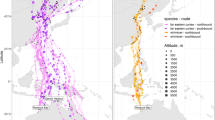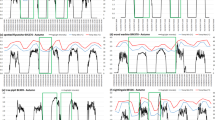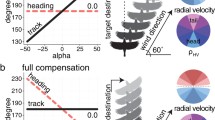Abstract
Meteorological conditions influence strongly the energy and water budget of birds. By adjusting their flights spatially and temporally with respect to these conditions, birds can reduce their energy expenditure and water loss considerably. By radar, we quantified songbird migration across the western Sahara in spring and autumn. There autumn migrants face the trade-off between (a) favorable winds combined with hot and dry air at low altitudes and (b) unfavorable winds combined with humid and cold air higher up. Thus, it can be tested whether birds may chose altitudes to minimize water loss instead of energy expenditure. We predicted optimal flight altitudes with respect to water loss and energy expenditure based on a physiological flight model when crossing the western Sahara and compared these model predictions spatially and temporally with measured songbird densities. The model aiming for minimal water consumption predicted a mean flight altitude of 3,400 m under autumn conditions. However, 64% of the nocturnal songbird migration flew at altitudes below 1,000 m above ground level profiting from tailwind. This preference for tailwind in autumn, despite the hot and dry air, emphasizes the importance of energy savings and diminishes the significance of possible water stress for the selection of flight altitude. Nevertheless, during daytime, high energy expenditure due to air turbulences and water loss due to warmer air and direct solar radiation prevent songbirds from prolonging their nocturnal flights regularly into the day. Birds crossing the Sahara save water by nocturnal flights and diurnal rests.





Similar content being viewed by others
References
Adams NJ, Pinshow B, Gannes LZ (1997) Water influx and efflux in free-flying pigeons. J Comp Physiol B 167:444–450
Alerstam T (1990) Bird migration. Cambridge University Press, Cambridge
Bairlein F (1987) The migratory strategy of the garden warbler: a survey of field and laboratory data. Ringing Migr 8:59–72
Bairlein F (1988) How do migratory songbirds cross the Sahara? TREE 3:191–194
Bairlein F, Totzke U (1992) New aspects on migratory physiology of trans-Saharan passerine migrants. Ornis Scand 23:244–250
Battley PF, Piersma T (2005) Body composition and flight ranges of bar-tailed godwits (Limosa lapponica baueri) from New Zealand. Auk 122:922–937
Berger M, Hart JS (1974) Physiology and energetics of flight. In: Farner DS, King JR (eds) Avian biology. Academic, San Francisco, pp 75–477
Berger M, Hart JS, Roy OZ (1971) Respiratory water and heat loss of the black duck during flight at different ambient temperatures. Can J Zool 49:767–774
Biebach H (1990) Strategies of Trans-Saharan migrants. In: Gwinner E (ed) Bird migration. Springer, Berlin, pp 352–367
Biesel W, Nachtigall W (1987) Pigeon flight in a wind tunnel. IV. Thermoregulation and water homeostasis. J Comp Physiol B 157:117–128
Bloch R, Bruderer B, Steiner P (1981) Flugverhalten nächtlich ziehender Vögel—Radardaten über den Zug verschiedener Vogeltypen auf einem Alpenpass. Die Vogelwarte 31:119–149
Bruderer B (1969) Zur Registrierung und Interpretation von Echosignaturen an einem 3-cm Zielverfolgungsradar. Der Ornithologische Beobachter 66:70–88
Bruderer B (1994) Nocturnal bird migration in the Negev (Israel)—a tracking radar study. Ostrich 65:204–212
Bruderer B (1997) The study of bird migration by radar. Part 1: the technical basis. Naturwissenschaften 84:1–8
Bruderer B, Underhill LG, Liechti F (1995) Altitude choice of night migrants in a desert area predicted by meteorological factors. Ibis 137:44–55
Butler RW, Williams TD, Warnock N, Bishop MA (1997) Wind assistance: a requirement for migration of shorebirds? Auk 114:456–466
Carmi N, Pinshow B (1995) Water as a physiological limitation to flight duration in migrating birds: the importance of exhaled air temperature and oxygen extraction. Isr J Zool 41:369–374
Carmi N, Pinshow B, Porter WP, Jaeger J (1992) Water and energy limitations on flight duration in small migrating birds. Auk 109:268–276
Engel S (2005) Racing the wind: water economy and energy expenditure in avian endurance flight. University of Groningen, Groningen
Engel S, Biebach H, Visser GH (2006a) Metabolic costs of avian flight in relation to flight velocity: a study in Rose Coloured Starling (Sturnus roseus, Linnaeus). J Comp Physiol B 176:415–427
Engel S, Biebach H, Visser GH (2006b) Water and heat balance during flight in the Rose-Colored Starling (Sturnus roseus). Physiol Biochem Zool 79:763–774
Engel S, Klaassen R, Klaassen M, Biebach H (2006c) Exhaled air temperature as a function of ambient temperature in flying and resting ducks. J Comp Physiol B 176:527–534
Engel S, Suthers RA, Biebach H, Visser GH (2006d) Respiratory water loss during rest and flight in European Starlings (Sturnus vulgaris). Comp Biochem Physiol A Mol Integr Physiol. 145:423–432
Erni B, Liechti F, Underhill LG, Bruderer B (2002) Wind and rain govern the intensity of nocturnal bird migration in central Europe—a log-linear regression analysis. Ardea 90:155–166
Erni B, Liechti F, Bruderer B (2005) The role of wind in passerine autumn migration between Europe and Africa. Behav Ecol 16:732–740
Gauthreaux SA (1991) The flight behavior of migrating birds in changing wind fields: radar and visual analyses. Am Zool 31:187–204
Giladi I, Pinshow B (1999) Evaporative and excretory water loss during free flight in pigeons. J Comp Physiol B 169:311–318
Green M (2003) Flight strategies in migrating birds: when and how to fly. Lund University, Lund
Haas W, Beck P (1979) Zum Frühjahrszug paläarktischer Vögel über die westliche Sahara. J Ornithol 120:237–246
Hedenström A, Alerstam T (1995) Optimal flight speed of birds. Phil Trans R Soc Lond B 348:471–487
Hedenström A, Rosén M (2003) Body frontal area in passerine birds. J Avian Biol 34:159–162
Hedenström A, Alerstam T, Green M, Gudmundsson GA (2005) Adaptive variation of airspeed in relation to wind, altitude and climb rate by migrating birds in the Arctic. Behav Ecol Sociobiol 52:308–317
Hirth KD, Biesel W, Nachtigall W (1987) Pigeon flight in a wind tunnel. III. Regulation of body temperature. J Comp Physiol B 157:111–116
Jenni L, Jenni-Eiermann S (1998) Fuel supply and metabolic constraints in migrating birds. J Avian Biol 29:521–528
Kerlinger P, Moore FR (1989) Atmospheric structure and avian migration. In: Power DM (ed) Current ornithology. Plenum, New York, pp 109–142
Klaassen M (1995) Water and energy limitations on flight range. Auk 112:260–262
Klaassen M (1996) Metabolic constraints on long-distance migration in birds. J Exp Biol 199:57–64
Klaassen M (2004) May dehydration risk govern long-distance migratory behaviour? J Avian Biol 35:4–6
Klaassen M, Biebach H (2000) Flight altitude of trans-Sahara migrants in autumn: a comparison of radar observations with predictions from meteorological conditions and water and energy balance models. J Avian Biol 31:47–55
Klaassen M, Kvist A, Lindström Å (1999) How body water and fuel stores affect long distance flight in migrating birds. In: Adams N, Slotow R (eds) Proc. 22 Int. Ornithol. Congr. University of Natal, Durban, pp 1450–1467
Klaassen M, Kvist A, Lindström Å (2000) Flight costs and fuel composition of a bird migrating in a wind tunnel. Condor 102:444–451
Kvist A (2001) Fuel and fly: adaptations to endurance exercise in migrating birds. Lund University, Lund
Kvist A, Klaassen M, Lindström Å (1998) Energy expenditure in relation to flight speed: what is the power of mass loss rate estimates? J Avian Biol 29:485–498
Kvist A, Lindström A, Green M, Piersma T, Visser GH (2001) Carrying large fuel loads during sustained bird flight is cheaper than expected. Nature 413:730–732
Landys MM, Piersma T, Visser GH, Jukema J, Wijker A (2000) Water balance during real and simulated long-distance migratory flight in the Bar-tailed Godwit. Condor 102:645–652
Liechti F (2006) Birds: blowin' by the wind? J Ornithol 147:202–211
Liechti F, Bruderer B (1995) Direction, speed and composition of nocturnal bird migration in the south of Israel. Isr J Zool 41:501–515
Liechti F, Bruderer B (1998) The relevance of wind for optimal migration theory. J Avian Biol 29:561–568
Liechti F, Bruderer L (2002) Wingbeat frequency of barn swallows and house martins: a comparison between free flight and wind tunnel experiments. J Exp Biol 205:2461–2467
Liechti F, Schmaljohann H (2007) Flight altitudes of nocturnal spring migrants over the Sahara governed by wind. In: Craig A (ed) Proc. Pan African Ornithol. Congress, Djerba, Ostrich 78:337–341
Liechti F, Klaassen M, Bruderer B (2000) Predicting migratory flight altitudes by physiological migration models. Auk 117:205–214
Masman D, Klaassen M (1987) Energy expenditure during free flight in trained and free-living Eurasian Kestrels Falco tinnunculus. Auk 104:603–616
McWilliams SR, Guglielmo CG, Pierce P, Klaassen M (2004) Flying, fasting, and feeding in birds during migration: a nutritional and physiological ecology perspective. J Avian Biol 35:377–393
Michaeli G, Pinshow B (2001) Respiratory water loss in free-flying pigeons. J Exp Biol 204:3803–3814
Pennycuick CJ (1989) Bird flight performance: a practical calculation manual. Oxford University Press, Oxford
Pennycuick CJ (1998) Computer simulation of fat and muscle burn in long-distance bird migration. J Theor Biol 191:47–61
Pennycuick CJ, Bradbury TAM, Einarsson O, Owen M (1999) Response to weather and light conditions of migrating Whooper Swans Cygnus cygnus and flying height profiles, observed with Argos satellite system. Ibis 141:434–443
Piersma T, Klaasen K, Bruggemann HJ, Blomert A, Gueye A, Ntiamoa-Baidu Y, Van Brederode NE (1990) Seasonal timing of the spring departure of waders from the Banc d'Arguin, Mauritania. Ardea 78:123–133
R Development Core Team (2007) R: A language and environment for statistical computing. R Foundation for Statistical Computing, Vienna, Austria. ISBN 3-900051-07-0, URL http://www.R-project.org.df
Rayner JMV (1990) The mechanics of flight and bird migration performance. In: Gwinner E (ed) Bird migration. Springer, Berlin, pp 283–299
Rayner JMV (2001) Fat and formation in flight. Nature 413:685–686
Richardson WJ (1991) Wind and orientation of migrating birds: a review. In: Berthold P (ed) Orientation in birds. Birkhäuser, Basel, pp 226–249
Rothe HJ, Biesel W, Nachtigall W (1987) Pigeon flight in a wind tunnel. II. Gas exchange and power requirements. J Comp Physiol B 157:99–109
Schaub M, Liechti F, Jenni L (2004) Departure of migrating European robins, Erithacus rubecula, from a stopover site in relation to wind and rain. Anim Behav 67:229–237
Schmaljohann H, Liechti F, Bruderer B (2007a) Daytime passerine migrants over the Sahara—are these diurnal migrants or prolonged flights of nocturnal migrants? In: Craig A (ed) Proc. Pan African Ornithol. Congress, Djerba, Ostrich 78:357–362
Schmaljohann H, Liechti F, Bruderer B (2007b) Songbird migration across the Sahara—the non-stop hypothesis rejected!. Proc R Soc Lond B 274:735–739. doi:10.1098/rspb.2006.0011
Schmaljohann H, Liechti F, Bruderer B (2007c) An addendum to “Songbird migration across the Sahara: the non-stop hypothesis rejected!”. Proc R Soc Lond 274:1919–1920
Schmaljohann H, Bruderer B, Liechti F (2008a) Sustained bird flights occur at temperatures beyond expected limits of water loss rates. Anim Behav 76:133–1138. doi:10.1016/j.anbehav.2008.05.024
Schmaljohann H, Liechti F, Bächler E, Steuri T, Bruderer B (2008b) Quantification of bird migration by radar—a detection probability problem. Ibis 150:342–355
Thomas ALR, Hedenström A (1998) The optimum flight speeds of flying animals. J Avian Biol 29:469–477
Torre-Bueno JR (1976) Temperature regulation and heat dissipation during flight in birds. J Exp Biol 65:471–482
Torre-Bueno JR (1978) Evaporative cooling and evaporative water loss in the flying birds. J Exp Biol 75:231–236
Ward S, Rayner JMV, Möller U, Jackson DM, Nachtigall W, Speakman JR (1999) Heat transfer from starlings Sturnus vulgaris during flight. J Exp Biol 202:1589–1602
Weber TP, Houston AI (1997) Flight costs, flight range and the stopover ecology of migrating birds. J Anim Ecol 66:297–306
Wikelski M, Tarlow EM, Raim A, Diehl RH, Larkin RP, Visser GH (2003) Costs of migration in free-flying songbirds. Nature 423:704
Zaugg S, Saporta G, van Loon E, Schmaljohann H, Liechti F (2008) Automatic identification of bird targets with radar via patterns produced by wing flapping. J R Soc Interface 5:1041–1053. doi:10.1098/rsif.2007.1349
Acknowledgments
We thank all those who helped to gather the data in Mauritania. We are most grateful to Thomas Steuri who engineered the radar hardware and the software together with Erich Bächler whom we also thank for assistance in the field. We thank the main supporters of our project: The Swiss Army and Oerlikon-Contraves AG for the radar equipment; for important financial support, we thank the Swiss National Science Foundation (Project No. 31-65349), the Foundations Volkart, Vontobel, MAVA for Nature Protection, Ernst Göhner, Felis and Syngenta, the companies Bank Sarasin and Co, Helvetia Patria Insurances and F. Hoffmann-La Roche AG, the European Science Foundation as well as BirdLife Switzerland and International. We would like to thank the authorities of Mauritania among them especially “Ministère du Dévelopement Rural et de l'Environnment, Direction de l'Environnment et de l'Aménagement Rural” and “Centre de Lutte Antiacridienne” for their support and assistance. Further partners are found under “www.vogelwarte.ch/sahara”. The Swiss Ornithological Institute was the stronghold of the whole project throughout. Meteorological data were kindly provided by the NOAA-CIRES Climate Diagnostics Center, Boulder, Colorado, from their web site at http://www.cdc.noaa.gov/. Marcel Klaassen kindly provided his software for the model calculations. We thank Lukas Jenni, Franz Bairlein, and two anonymous referees for valuable comments on the manuscript. Our study complied with the animal care laws of Mauritania.
Author information
Authors and Affiliations
Corresponding author
Additional information
Communicated by W. Wiltschko
Rights and permissions
About this article
Cite this article
Schmaljohann, H., Liechti, F. & Bruderer, B. Trans-Sahara migrants select flight altitudes to minimize energy costs rather than water loss. Behav Ecol Sociobiol 63, 1609–1619 (2009). https://doi.org/10.1007/s00265-009-0758-x
Received:
Revised:
Accepted:
Published:
Issue Date:
DOI: https://doi.org/10.1007/s00265-009-0758-x




